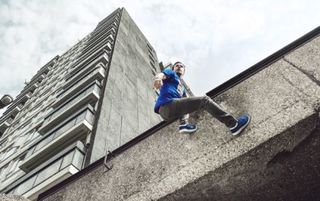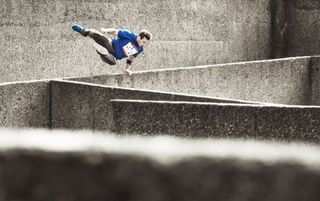Sports photography tips
Take better action shots with advice from three professional sports photographers
In This Series
- Sports photography tips
- Sports photography tips
- Sports photography tips
To inspire a generation of photography enthusiasts, Nikon invited three pro photographers from across Europe to share their tips on how to capture skateboarding, freestyle football and Parkour. The adrenaline-fuelled nature of street sports makes them ideal for photography enthusiasts keen to think creatively about their subject, regardless of their expertise, or the equipment they own.
Parkour
Born in Romania, Claudiu Voicu, 26, is a professional street sports photographer and videographer. A former Parkour athlete himself, he first developed his cinematic eye by capturing fellow Parkour athletes on video, before eventually turning his attention to still photography. One of the primary contributors of the free-running movement in Europe, he’s been involved with Parkour for over a decade and has been shooting stills professionally for the past four years.

As a teenager, the area that he used to play street hockey on was redeveloped. At a loss for what to do in his spare time, he and his friends discovered they could jump between the concrete structures of their houses and use their own athleticism to entertain themselves. Put simply, they had discovered ‘freerunning’, a mix of extreme sports and martial arts that has taken Europe by storm since the late 1990s.

Stylistically, Voicu likes to emphasise colours and capture adrenaline in his shots. ‘I see the movements in the locations,’ says Voicu. He chooses to work very closely with his subjects, making calls like a movie director to signal the start of an energetic sequence or series of jumps. To separate the subject from the backdrop – both equally as important in Parkour photography – Voicu chooses to contrast the frequently neutral, earthy colours of distressed architecture with vivid colours on his subjects’ clothing. Visually, combining a bright red T-shirt with vibrant red shoes, front flips, footwork and feats of physical strength can really stand out against speckled grey walls.

‘Trial and error makes the concept of shooting Parkour accessible to anyone,’ says Voicu. ‘The athletes express themselves freely, and that’s reflected in the way freerunning is photographed. Parkour itself is about self-improvement, it’s about pushing the boundaries of what’s achievable and like any extreme sport, this involves an element of danger. To capture this, I use a wide lens to intensify the spectacle unfolding before me. If there’s a huge drop, or unnerving gap for a freerunner to jump, revealing it can add emotive context, in the form of adrenaline, to the still.’
Claudiu Voicu’s tips for shooting Parkour
Shoot raw Carry a large SD card to capture raw files that can be manipulated in post-production, and invest in a wide angle lens.
Choose inspiring locations The urban landscape is your obstacle course, visualising the location before a shoot is crucial.
Capture colourful clothing Think carefully about what your subjects are wearing in order to make them stand out from their surroundings.
On the next page: freestyle football
Olly Burn, 29, is a professional reportage and sports photographer from London. Ever since picking up his first DSLR camera at university – a Nikon D70 – Olly has embraced his passion for capturing the outdoor world around him and places his rapport with people at the heart of his digital work.
Get the Coach Newsletter
Sign up for workout ideas, training advice, reviews of the latest gear and more.
There’s nothing staged about Burn. In his world, interaction and spontaneity are the elements of intrigue and surprise that motivate his trigger finger. ‘My philosophy is to shoot as much and as often as possible,’ says Burn. ‘I like to experiment with light and pay attention to everything that inspires me, from movies to magazines, emotions and expressions.’
A perceptive photographer, Burn is attracted to the creativity and fluidity that freestyle football embodies. Quick off the mark and vocal in his direction, he prefers to switch his DSLR to auto-focus and let the action in front of him compose the photo. In direct sunlight for a shoot with pro football-freestyler Abbas Farid, Olly took the ISO as low as possible, chose a shallow depth of field and wide aperture, and kept a close eye on his shutter speed at all times. By using the D5200’s 39-point auto focus he was able to follow the dazzling footwork and revolving football with his viewfinder, primed and ready to capture even the most unpredictable of movements from the athlete.
‘There is a misconception that the better the camera you have, the better photographer you will be,’ says Burn. ‘But many professional high-end features are now available on smaller cameras that allow you to do more, for less.’
Rich, textured images of athletic rainbow kicks and breathtaking ball skills set against mottled street-level backdrops make freestyle football one of the most difficult street sports to shoot well. To add fantasy and intrigue to his still photographs, Olly chooses to shoot directly into the sun and use the eclipse of local architecture to showcase his signature style and inject some flare.
Be alert Shoot fluidly so you don’t miss unexpected tricks.
Don’t be too precious Shoot more than you need, with digital storage on DSLRs there is no reason to hold back.
Embrace the surrounding environment Freestyle football can be done almost anywhere, incorporate the backdrop and the weather into your shots.
Anglo-Dutch pro photographer Tom van Schelven, 28, has been shooting street sports for the past four years. He has an intuitive attitude towards photography, built upon the notion that ’if your camera is always on, your instincts will direct the lens’. Unquestionably dedicated and remarkably daring, he is right at home sat between the concrete valleys of a sun-kissed skatepark.
Since turning professional, Van Schelven has travelled the world living life through his viewfinder. A fan of street sports himself, he got involved in skate shoots when he worked as a photography assistant and realised the variety of shot compositions in skateboarding could bring his own portfolio to life. Flips, grabs, grinds and airtime require superfast shutter speeds and Van Schelven’s graphic style of photography is epitomised by the harsh lighting and fluid movement he looks for when isolating subjects and reducing anything from the shot that disturbs the focus.
Keen to direct, and equally willing to receive input from skaters, he’ll continually get creative to catch a perfect shot, using manual settings. To shoot pro-skater Jak Tonge, he went out of his way to perch atop a ladder at the edge of a quarter pipe and crawl in the depths of a graffiti-laden bowl to experiment with new angles.
‘For me, the Nikon D5200’s 24.1 megapixel resolution has a high enough pixel count to take a wide shot from a precarious vantage point and crop it down afterwards without losing any quality,’ says Van Schelven. ‘I love shooting skateboarding like this, and you’ll see it often in my work. My lens of choice is the NIKKOR 24mm-70mm f/2.8 as it provides the flexibility required to adapt with the skater’s rapid movements.’
Know your subject To capture really stunning shots, study the body language of the skater to anticipate their movements
Think about lighting Shadows and surface reflection can actually enhance your images if you pay them enough attention
Aspire to simplicity Look for crisp, clean contrasts and minimal subject matter
Coach is a health and fitness title. This byline is used for posting sponsored content, book extracts and the like. It is also used as a placeholder for articles published a long time ago when the original author is unclear. You can find out more about this publication and find the contact details of the editorial team on the About Us page.

